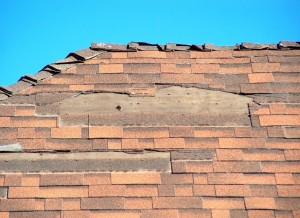Common Roofing Damages Caused by Hurricanes and High Winds
 Hurricane, tropical storms and windstorms are devastating to roofs. High winds tear off shingles and other roofing material and leave the wood roof deck vulnerable to the damaging effects of rain. In some cases, roofs can be torn off completely, even where hurricane straps are in use. Here are common roofing damages caused by hurricanes and high winds. You’ll find more details in our article Inspecting Your Roof After a Hurricane, Where to Look for Roofing Damages.
Hurricane, tropical storms and windstorms are devastating to roofs. High winds tear off shingles and other roofing material and leave the wood roof deck vulnerable to the damaging effects of rain. In some cases, roofs can be torn off completely, even where hurricane straps are in use. Here are common roofing damages caused by hurricanes and high winds. You’ll find more details in our article Inspecting Your Roof After a Hurricane, Where to Look for Roofing Damages.
1. Missing or Damaged Roofing Material
High winds get under shingles and tear them from the roof. Hail during the storm or blown debris can also damage asphalt shingles, wood shingles and shakes, clay tiles and other vulnerable types of roofing material.
2. Damaged Ridge Vents
Most newer homes have ridge venting that allows hot air and moisture to escape from the attic. Since they are right at the peak of the roof, they are vulnerable to high winds. If they are damaged, rain can quickly penetrate the attic and cause serious damage. Inspect ridge vents carefully for damage.
3. Missing or Shifted Flashing
Step flashing is an important element of a home’s roofing. It offers protection around chimneys or against external walls of a dormer or upper story. In high winds, or as the result of wind-driven debris, flashing can be lost. Most often it is damaged or shifted, producing a gap between the roof and the chimney or home. This provides easy access to rain water.
4. Damaged Pipe Jacks and Boots
Vent stacks protrude from your roof to vent the chimney or sewer. Most have a rubber boot nailed to the roof under the shingles. That boot can easily be damaged in high winds or in heavy hail associated with hurricanes and tropical storms. Look carefully for holes and cracks in these boots.
5. Skylights, Vents and Attic Fans
All of these things require a hole to be cut into the roof deck and they must be properly gasketed and sealed to hold out water. In heavy storms, damage can occur that allows rainwater to flow under the roofing material or straight into your home or attic. Knowing how to inspect a skylight or other intentional hole is very important.
6. Eaves
High winds can threaten to lift a roof off the home when it hits under the eaves. Even if the roof is not dislodged, damage to the eaves can occur. While not so much of a risk for water leaks, damage to eaves can become an easy access for insect infestation.
7. Gutters
The gutters on your home do more than keep you from getting dripped on when you walk in or out the door. Their primary task is to collect water and carry it safely away from your home’s foundation. Missing or damaged gutters might allow an enormous amount of water to fall against your home’s foundation where it can easily flood your basement.
Summary
If you find any damage to your roof, call your insurance company immediately and then call a licensed roofer. The next step is to get the damaged areas covered so that subsequent storms don’t cause additional damage and pour more water onto a vulnerable roof and into your home. See our article on Quick Fixes for a Leaking Roof While You Wait for the Repairman.
When a heavy storm has passed through, wait until it is safe and then inspect your roof for these types of damage. If you find any of them, take immediate action to make sure your home is safe and you are following your insurance policy that likely says you must act to covered damaged areas temporarily until they can be fixed.
